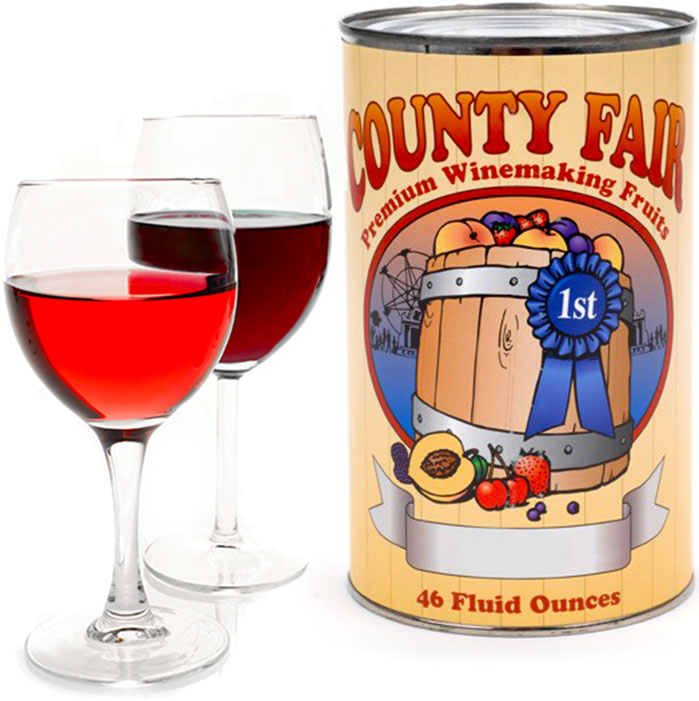 I’m having trouble understand how may cans of County Fair Fruit Bases to use. It says that you can use 1 to 4 cans to make 5 gallons of homemade wine. How many cans of the these wine making fruit bases should I use to make the best wine?
I’m having trouble understand how may cans of County Fair Fruit Bases to use. It says that you can use 1 to 4 cans to make 5 gallons of homemade wine. How many cans of the these wine making fruit bases should I use to make the best wine?
Thanks Wanda
—–
Wanda,
The number of cans of fruit base you use controls how light or heavy-bodied the wine will be. Using one particular number of cans is not necessarily better or worse than using another. It’s just different and subject to personal tastes and preferences.
If you like a crisp, refreshing wines, one that would goes great outdoors in the summer months, then you would use one or two cans of fruit base. These wines will be more thirst-quenching on the palette. If you prefer bold, full-bodied wines, one that might go well after dinner, than you would use three or four cans of the wine making fruit base. These wines will have a lot more body with a longer, more-layered finish. Regardless of the number of cans you use, the wine will turn out equally well in terms of quality. It’s more of a matter of personal taste.
On the side of each can of County Fair Fruit Base you are provided with the wine recipes and directions for each number of cans, from one to four. The wine making process is the same in each case, but the amounts of other wine making ingredients vary slightly. This is necessary to keep the wine’s flavor in balance.
So to answer your question more directly, you will need to decide how many cans of wine making fruit base are right for you. It’s a question of tastes, not whether it’s good or bad. Regardless of the number of cans of wine making fruit base you choose, follow the wine recipe on the side of the label and you will turn out a remarkable fruit wine… one you’ll be proud to share with family and friends.
Happy Winemaking,
Ed Kraus
—–
Ed Kraus is a 3rd generation home brewer/winemaker and has been an owner of E. C. Kraus since 1999. He has been helping individuals make better wine and beer for over 25 years.
Author Archives: AIH
Brewing Beer With Corn (Maize) – History and Technique
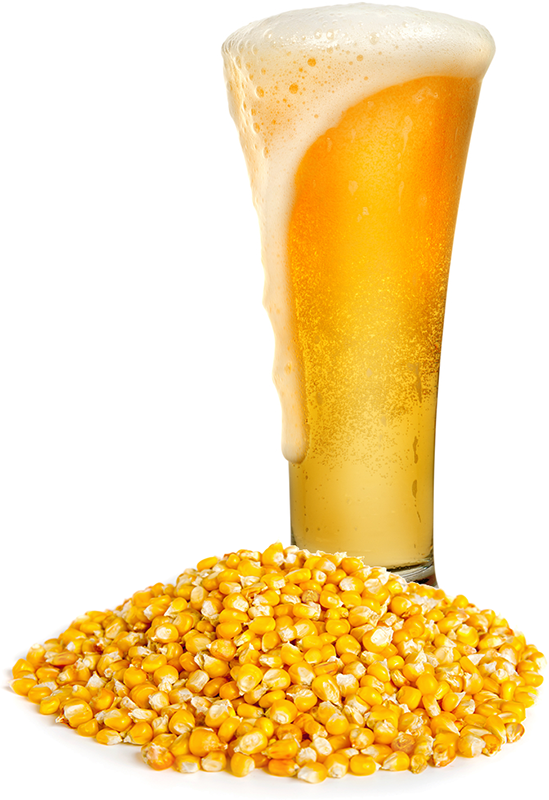 Corn, also known as maize, is most frequently used in brewing as an adjunct grain to lighten beer body, color, and flavor. Though the macro brewers bastardized its use to some extent, today’s craft brewers may find that using corn in beer has its place. Some styles (cream ale, for one) have found a home among brewers who hope to demonstrate that it is possible to make artistic, flavorful beer with maize.
Corn, also known as maize, is most frequently used in brewing as an adjunct grain to lighten beer body, color, and flavor. Though the macro brewers bastardized its use to some extent, today’s craft brewers may find that using corn in beer has its place. Some styles (cream ale, for one) have found a home among brewers who hope to demonstrate that it is possible to make artistic, flavorful beer with maize.
Corn actually played a significant role in brewing long before the modern craft beer revolution. Foreseeing the need for a potable beverage, the earliest European settlers carried malt with them to the New World. But when that ran out, they often turned to brewing beer with corn. Malting maize turned out to be quite a challenge, but the determined settlers found a way to make it work — two ways in fact, as shared in the book Brewed in America.
The easiest method was to bake copious amounts of corn bread. When it came time to make beer, the brewers would just toss the loaves right in the mash tun to make wort! This avoided the process of malting the maize, which turned out to be more difficult than malting barley or wheat.
For those determined to malt the local maize, they found that the best way to do this was to dig a large hole in the ground, wait for the corn to sprout, dig it all up again, wash it, then kiln it. Clearly these settlers were desperate for beer!
Even before the colonists arrived in the New World, chicha was brewed in South America among the Peruvian Incas. Dogfish Head’s Sam Calagione attempted a chicha, and while the end result doesn’t sound very authentic, it’s definitely entertaining to read about.
Of the craft brewers making beer with corn, one in particular stands out. Charlottesville, VA’s Starr Hill Brewing Company researched what Thomas Jefferson might have brewed at Monticello and developed a beer recipe for their limited release Monticello Reserve Ale. Flaked corn is used for a touch of sweet corn flavor, but it’s not at all overwhelming. The beer won a Silver Medal at the 2011 Great American Beer Festival.
Methods for Brewing Beer with Corn
Because corn has a higher gelatinization temperature than barley, it must be cooked prior to mashing. Malting corn is a difficult process and as a result, most brewers will use one of the three forms below:
- Flaked Maize – Flaked maize can account for as much as 20-40% of the total grain bill, depending on the style. The corn is pressed through hot rollers, so the flakes can be added directly to the mash without prior cooking.
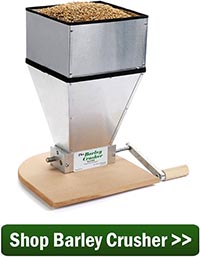
- Corn Grits – Corn grits must be cooked in a separate vessel before being added to the mash. Otherwise, use them in the same way as flaked corn.
- Corn Sugar – Most commonly used as priming sugar, corn sugar can also be added to the kettle to increase alcohol content without significantly affecting body, color, or flavor. I wouldn’t advise using more than a pound in a five-gallon batch, two at the most, otherwise your beer may become thin and cidery.
Interested in brewing beer with corn or maize? Consider the Brewer’s Best Cream Ale Recipe Kit.
—–
David Ackley is a beer writer, brewer, and self-described “craft beer crusader.” He holds a General Certificate in Brewing from the Institute of Brewing and Distilling and is founder and editor of the Local Beer Blog.
Can I Add Sugar During Fermentation?
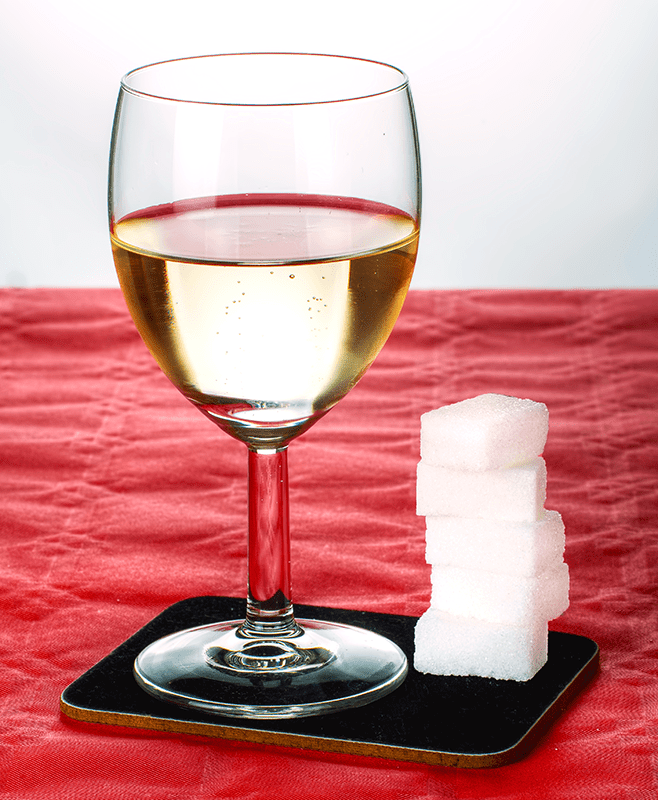 When making wine should I add all the sugar all at once or can I add sugar to the wine during the fermentation?
When making wine should I add all the sugar all at once or can I add sugar to the wine during the fermentation?
Name: Mark
State: Ohio
——
Hello Mark,
In general, you do not want to add sugar during fermentation. You will want to add all the sugar to the wine before the fermentation – all at once, upfront. There is no real advantage to spreading the sugar throughout the primary fermentation, just as long as you are shooting for a reasonable level of alcohol (10% to 14%). Any wine yeast you choose to use will be able to readily ferment to this level of alcohol, even when all the sugar is added to the wine must before the fermentation.
The biggest reason you’ll want to add all the table sugar all at once, besides the fact it’s less work, is that it makes it easier to calculate your wine’s finished alcohol.
Sugar is what turns into alcohol during the fermentation. This is fermentation 101. To know how much alcohol the fermentation is making, you have to know how much sugar has been fermented. This requires you to know how much sugar the fermentation started with and how much sugar the fermentation ended with. The difference is what was fermented into alcohol. Both of these things can be easily determined with a hydrometer by taking a reading before and after the fermentation and comparing the two.
 If you add sugar to the wine during the fermentation, additional hydrometer readings will need to be logged to eventually know how much alcohol is in the wine. These additional calculations can be annoying and even hard to remember to do. It requires you to pull out the hydrometer each time you want to add more sugar and take a specific gravity reading both before and after the addition of the additional sugar.
If you add sugar to the wine during the fermentation, additional hydrometer readings will need to be logged to eventually know how much alcohol is in the wine. These additional calculations can be annoying and even hard to remember to do. It requires you to pull out the hydrometer each time you want to add more sugar and take a specific gravity reading both before and after the addition of the additional sugar.
The only possible time you would want to add sugar fermentation is if you intend to make a high-alcohol wine. In this case you would want to start out the fermentation with enough sugar to reach 13% or 14% alcohol. Then as the fermentation runs out of sugar – which is determined with hydrometer readings – you will want to start feeding sugar to the fermentation in intervals.
The goal is to end up with a wine that is high in alcohol but not too sweet to drink. The fermentation will come to a point where the wine yeast can do no more. Exactly when that will be is not a certainty. It varies from one fermentation to the next, depending on a number of variables. When this happens you want little to no remaining sugar in the wine. This is the reason why you would feed the sugar to the fermentation as it progresses beyond 14%.
 So in the end I guess the answer to the question: “can I add sugar during fermentation?”, is yes you can. With the only side note being “but it only makes sense if you are making a high alcohol wine”. For any normal wine making situation, it is only creating more work to do so.
So in the end I guess the answer to the question: “can I add sugar during fermentation?”, is yes you can. With the only side note being “but it only makes sense if you are making a high alcohol wine”. For any normal wine making situation, it is only creating more work to do so.
Happy Winemaking,
Ed Kraus
—–
Ed Kraus is a 3rd generation home brewer/winemaker and has been an owner of E. C. Kraus since 1999. He has been helping individuals make better wine and beer for over 25 years.
5 Summer Beer Styles That Taste Better Outdoors
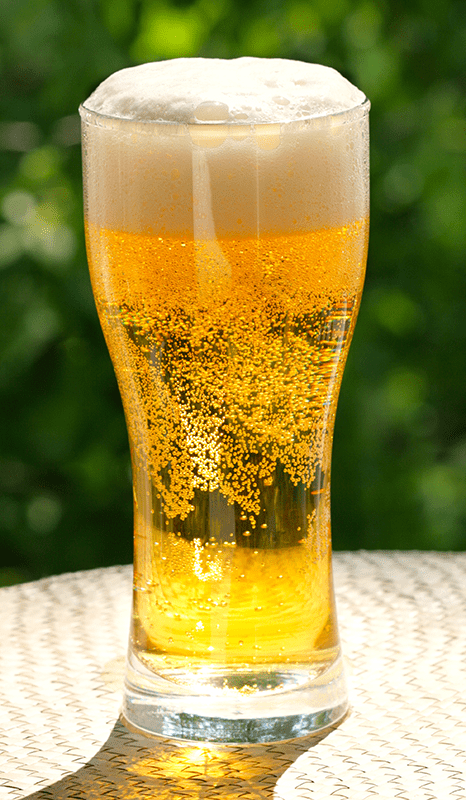 When asked what are some good summer beer styles for drinking outdoors, I’m inclined to say, “the one in your hand.” But some beer styles lend themselves to drinking in the summer some more than other, and likewise, there are some beer recipes that lend themselves to being brewed in the summer. This isn’t the time or place for heavy dopplebocks or Russian imperial stouts (though I certainly wouldn’t fault you for enjoying one on the back porch!). These summer beer styles are relatively sessionable yet still full of flavor.
When asked what are some good summer beer styles for drinking outdoors, I’m inclined to say, “the one in your hand.” But some beer styles lend themselves to drinking in the summer some more than other, and likewise, there are some beer recipes that lend themselves to being brewed in the summer. This isn’t the time or place for heavy dopplebocks or Russian imperial stouts (though I certainly wouldn’t fault you for enjoying one on the back porch!). These summer beer styles are relatively sessionable yet still full of flavor.
Below are five of my favorite summer beer styles for outdoor drinking:
- Kölsch – A light, crisp effervescence with just enough hop bitterness to keep things interesting. A slight fruity aroma may be present due to the use of an authentic Kölsch yeast. Some noble hop flavor may be perceptible and a little wheat may be used for flavor. A dry finish makes it a great thirst quencher.
- Rauchbier – Though not yet very popular stateside, German smoked beer can be a very pleasant summer beverage. The smoked malt flavor is reminiscent of barbeque or campfire and may pair well with grilled meats like bratwurst, steak, and lamb. A rauchbier isn’t for everyone – some may be turned off by the smokiness. But for the more adventurous, a smooth, smoky rauchbier is an excellent summer beer style option for drinking outdoors.
- Pilsner – Like Kölsch, pilsner is light, crisp, and dry with a firm noble hop bitterness. Unlike Kölsch, pilsner is a true lager and may feature more grain flavor and more assertive hop flavor. There are three types of pilsner (German, Czech, and American) and all three would be enjoyable during outdoor festivities.
- California Common – California common is another ale-lager hybrid, fermented with a lager yeast on the cooler side of ale temperatures, usually around 60-65˚F. Color for this beer style can range from light to dark amber. Hop bitterness is significant, usually 30-45 IBUs. The malt flavor has some toasted and caramel notes, while hop flavor can range from medium to high. Anchor Steam, the original California Common, uses all Northern Brewer hops.
- Saison –
 Any list of summer beer styles would be incomplete without saison. Developed in the French-speaking part of Belgium, saison was a classic thirst quencher among farmers and farmhands. A Belgian saison features a complex spicy and fruity yeast character, a crisp effervescence, and a dry finish. There may be a slight tart note. Many saisons use herbs and spices for additional flavoring and complexity, anything from coriander and orange peel to peppercorns and lemongrass. Next time you’re on the farm, don’t forget the saison!
Any list of summer beer styles would be incomplete without saison. Developed in the French-speaking part of Belgium, saison was a classic thirst quencher among farmers and farmhands. A Belgian saison features a complex spicy and fruity yeast character, a crisp effervescence, and a dry finish. There may be a slight tart note. Many saisons use herbs and spices for additional flavoring and complexity, anything from coriander and orange peel to peppercorns and lemongrass. Next time you’re on the farm, don’t forget the saison!
These are just five of my favorite summer beer styles for drinking outdoors. There are others. What are your favorites?
—–
David Ackley is a beer writer, brewer, and self-described “craft beer crusader.” He holds a General Certificate in Brewing from the Institute of Brewing and Distilling and is founder and editor of the Local Beer Blog.
Want A Balanced Beer? Calculate The BU:GU Ratio
 We all know that some beers are more bitter than others. Perhaps you’ve noticed that high gravity barley wines and double IPAs often have IBUs (International Bittering Units) in the 80s, 90s, or above. Without substantial hop bitterness, these beers would come across as excessively sweet.
We all know that some beers are more bitter than others. Perhaps you’ve noticed that high gravity barley wines and double IPAs often have IBUs (International Bittering Units) in the 80s, 90s, or above. Without substantial hop bitterness, these beers would come across as excessively sweet.
On the other hand, some beers are more malt forward. Belgian tripels, for example, can be just as alcoholic as double IPAs, but the tripel features phenolics, esters, and malt character, whereas the double IPA tends to be focused on the hops.
What we find in comparing beer styles is that balance can be calculated by comparing the hop bitterness to the original gravity of the beer recipe. It is this IBU and OG balance relationship that primarily controls a homebrew’s hoppy impression or the relative bitterness.
Let’s explore this relationship with some easy math.
Bitterness Units / Gravity Units Ratio
To calculate the BU:GU ratio, simply multiply the original gravity by 1000 then subtract 1000 to get the gravity units: (1.050 * 1000)-1000 = 50. Another way to say this is move the decimal place over three spaces and get rid of the “1” on the left. Now divide the IBUs by the gravity units to get the BU:GU ratio.
Let’s go back to our double IPA/Belgian tripel comparison. In the first example, we have the original gravity and the IBUs for a hypothetical double IPA:
Double IPA OG: 1.080
Double IPA IBUs: 80
BU/GU = 80/80 = 1.00
That’s a pretty bitter beer!
Now let’s calculate the BU:GU ratio for a Belgian tripel:
Tripel OG: 1.079
Tripel IBUs: 37
BU/GU = 0.47
In this case, the bitterness of the tripel is not nearly as prominent as the IPA.
The BU:GU ratio may range from as low as 0.20 for the least bitter beers and as high as 1.00 or more for IPAs and other highly hopped beers. To give you an idea of the range, let’s look at some BU:GU ratios from some of our most popular beer recipe kits:
- Steam Freak Pilsner Urkel (Clone): 1.14
- Steam Freak Steam Stoker Stout: 0.76
- Steam Freak Babbage Brown Porter: 0.56
- Brewers Best American Pale Wheat: 0.53 – 0.56
- Brewers Best Belgian Dark Strong: 0.33 – 0.38
- Brewers Best American Cream Ale: 0.33
These BU:GU ratios gives us a good indication of the hop bitterness compared to the original gravity. However, there are other secondary factors that can affect the relative bitterness, as well, including dryness (from a low final gravity), astringency (as from roasted grains), and other flavor and mouthfeel characteristics. You may want to take these into consideration when trying to produce a well balanced beer.
For example, a high proportion of caramel malt in the double IPA example may help take some of the edge off the IBUs, while the dryness of the tripel may make it seem more bitter than the IBUs suggest.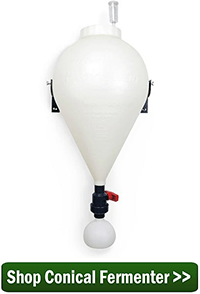
I’d encourage you to explore the BU:GU ratio for some of your favorite beers to figure out how you define good balance. Try calculating the ratio for some of your homebrews and use this number to determine whether you’ve hit the mark or not on hop bitterness and balance.
What to learn more about IBU and OG balance? Ray Daniels examines BU:GU ratios for many of the most common beer styles in his book Designing Great Beers.
—–
David Ackley is a beer writer, brewer, and self-described “craft beer crusader.” He holds a General Certificate in Brewing from the Institute of Brewing and Distilling and is founder and editor of the Local Beer Blog.
Pliny the Elder Clone Beer Recipe (All-Grain & Extract)
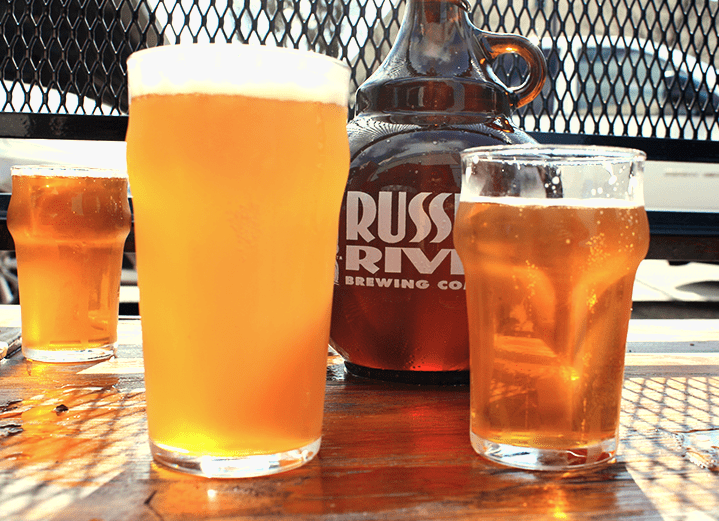 Pliny the Elder is a Double IPA and one of the top five most highly rated beers on Beer Advocate. It’s brewed by Russian River Brewing Company in Santa Rosa, CA, and is named for the Roman scholar who reportedly gave hops their original botanical name way back in the first century AD. With enough IBUs to tear the enamel off your teeth, Pliny the Elder is extremely popular and can be hard to find – why not brew your own?
Pliny the Elder is a Double IPA and one of the top five most highly rated beers on Beer Advocate. It’s brewed by Russian River Brewing Company in Santa Rosa, CA, and is named for the Roman scholar who reportedly gave hops their original botanical name way back in the first century AD. With enough IBUs to tear the enamel off your teeth, Pliny the Elder is extremely popular and can be hard to find – why not brew your own?
This Pliny the Elder clone beer recipe comes from the book Brewing Classic Styles by Jamil Zainasheff and John Palmer. Vinnie Cilurzo, co-owner and brewmaster at Russian River, contributed to the beer recipe specifically for the book, so you can be sure it’s close to the real thing!
The clone beer recipe below assumes a mash efficiency of 83% and a 90-minute boil time. It also uses nearly seven ounces of dry hops, so if needed, review our Quick Guide to Dry Hopping Your Homebrew. Good luck!
“Hop Hammer” – Pliny the Elder Clone Beer Recipe
(6-gallon batch, all-grain version)
Specs
OG: 1.080
FG: 1.013
ABV: 8.9%
IBU: 100+
SRM: 6
Ingredients
 15.25 lbs. American two-row malt
15.25 lbs. American two-row malt
0.5 lb. Wheat malt
1.5 lb. Corn sugar
0.5 lb. Crystal 40L malt
2 oz. Warrior hops at 90 mins (30 AAU)
2 oz. Chinook hops at 90 mins (26 AAU)
1 oz. Simcoe hops at 45 mins (12 AAU)
1 oz. Columbus hops at 30 mins (14 AAU)
2.25 oz. Centennial hops at 0 mins (20.25 AAU)
1 oz. Simcoe hops at 0 mins (12 AAU)
3.25 oz. Columbus hops, dry hop for 7-10 days (45.5 AAU)
1.75 oz. Centennial hops, dry hop for 7-10 days (15.75 AAU)
1.75 oz. Simcoe hops, dry hop for 7-10 days (21 AAU)
Wyeast 1056: American Ale Yeast or Fermentis Safale US-05
 Directions: The day before brewing the Pliny the Elder clone beer recipe, prepare a yeast starter sufficient for an OG of 1.080. On brew day, mash the crushed grains at 150˚F in approximately 5 gallons of water. Lauter and sparge to collect 7.75 gallons of wort. Bring to a boil. Add hops according to schedule. Mix in corn sugar just before flameout. Ferment at 67˚F, slowly raising the temperature to 70˚F towards the end of primary fermentation. When most of the yeast has settled, transfer to a secondary fermenter and add the dry hops. Dry hop for 7-10 days. Bottle or keg for 2-2.5 vols CO2 of carbonation.
Directions: The day before brewing the Pliny the Elder clone beer recipe, prepare a yeast starter sufficient for an OG of 1.080. On brew day, mash the crushed grains at 150˚F in approximately 5 gallons of water. Lauter and sparge to collect 7.75 gallons of wort. Bring to a boil. Add hops according to schedule. Mix in corn sugar just before flameout. Ferment at 67˚F, slowly raising the temperature to 70˚F towards the end of primary fermentation. When most of the yeast has settled, transfer to a secondary fermenter and add the dry hops. Dry hop for 7-10 days. Bottle or keg for 2-2.5 vols CO2 of carbonation.
EXTRACT VERSION: Replace the two-row and wheat malt with 10.9 lbs. of light LME and 0.5 lb. of wheat LME. Steep the crushed caramel malt for about 30 minutes at 150˚F before mixing in the malt extracts and proceed with the beer recipe.
—–
David Ackley is a beer writer, brewer, and self-described “craft beer crusader.” He holds a General Certificate in Brewing from the Institute of Brewing and Distilling and is founder and editor of the Local Beer Blog.
10 Tips For Putting Your Homebrew Through A Secondary Fermentation
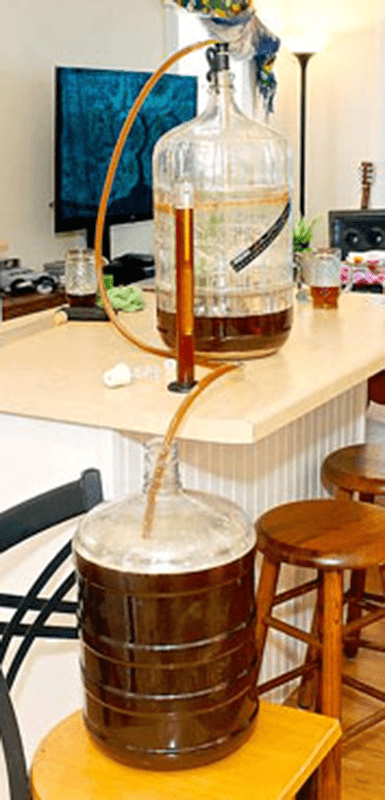 Many homebrewers consider a secondary fermentation to be a worthwhile step when brewing beer. For the time it takes to move a batch of beer from a primary fermenter to a secondary fermenter, it offers a number of opportunities to improve your homebrew and make the best beer that you can.
Many homebrewers consider a secondary fermentation to be a worthwhile step when brewing beer. For the time it takes to move a batch of beer from a primary fermenter to a secondary fermenter, it offers a number of opportunities to improve your homebrew and make the best beer that you can.
Check out these ten tips for putting your beer through a secondary fermentation. Most are just suggestions, but the first is imperative:
- Sanitation, sanitation, sanitation – Don’t spoil you hard work by being lax at this stage! Thoroughly clean and sanitize the secondary fermenter as well as your hoses and tubing used to transfer the beer. Be sure to sanitize the airlock as well and fill with either clean water or a diluted vodka solution.
- Use an Auto-Siphon – Transferring the beer is much easier with an Auto-Siphon. It’s one of the most cost-effective upgrades you can make as a homebrewer. The Auto-Siphon will prime your siphon flow for you with just one pump. It’s a no-brainer for the homebrewer who routinely does secondary fermentations.
- Take a hydrometer sample – Transferring to a secondary fermenter offers a good opportunity to check in on your beer’s gravity — and while you’re at it, clarity, too. This is a good time to head off any potential issues while you still can. Remember to record the gravity in your homebrewing notes.
- Add sugars – If you find that your alcohol content is a little lower than you’d like, you can add additional sugars when putting your beer into secondary fermentation. It can be corn sugar, brown sugar, honey, or dried malt extract…any fermentable ingredient can be used to boost gravity. Most should be dissolved in clean, sterile water before mixing.
- Add clarifiers – Many brewers choose to add finings, or clarifiers, when doing a secondary fermentation on their beer. Gelatin or isinglass may be added at this stage.
- Add water
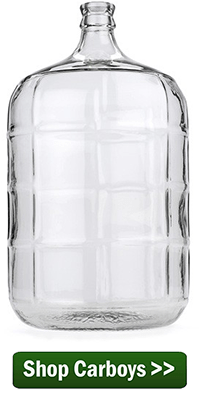 – If you find you’re short on volume and can afford to spare some alcohol content, you may want to mix in a small amount of sterile water to the fermenter. Boil the water for 20 minutes and allow to cool to the temperature of the beer, stirring it in using a sanitized spoon. Use a dilution calculator to figure out how much water to add.
– If you find you’re short on volume and can afford to spare some alcohol content, you may want to mix in a small amount of sterile water to the fermenter. Boil the water for 20 minutes and allow to cool to the temperature of the beer, stirring it in using a sanitized spoon. Use a dilution calculator to figure out how much water to add.
- Add dry hops – A secondary fermentation is also an opportunity to boost your beer’s hop flavor and aroma. Check out our Quick Guide to Dry Hopping Your Homebrew Beers for advice.
- Add herbs or spices – Just like dry hopping, you can “dry spice” your homebrew with herbs and spices. Remember: a little goes a long way!
- Keep the temperature stable – Big swings in the secondary fermentation temperature can lead to off-flavors. Read these tips for controlling homebrew fermentation temperatures.
- Try it in the keg – If you’re set up with a homebrew draft system, you can do a secondary fermentation right in the keg. Sediment at this stage will be minimal, just keep the keg vent open so the fermentation does not build up to much pressure. Then all you have to do is force carbonate after the secondary fermentation period.
What other techniques do you use during your beer’s secondary fermentation to ensure a successful homebrew?
—–
David Ackley is a beer writer, brewer, and self-described “craft beer crusader.” He holds a General Certificate in Brewing from the Institute of Brewing and Distilling and is founder and editor of the Local Beer Blog.
Using Finings In Beer For That Professional Look
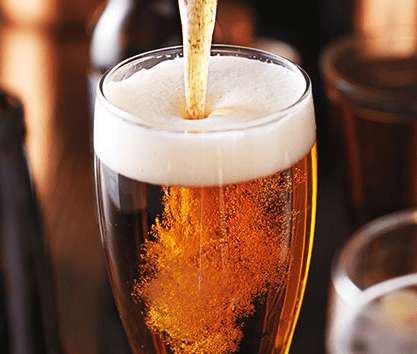 Professional brewers often filter their beers to make them clearer, but homebrewers can also achieve clarity without a filter. Enter: beer finings.
Professional brewers often filter their beers to make them clearer, but homebrewers can also achieve clarity without a filter. Enter: beer finings.
Using finings in beer will give it a brilliantly clear appearance. While clarity may not affect a drinker’s perception of aroma or flavor, appearance makes a key first impression when evaluating your homebrew.
Home brew beer finings work by electromagnetically attaching themselves to some of the materials which cause haze: protein, yeast, tannins. Sounds pretty science-y, I know, but you don’t need a Ph. D. to make clear beer! Here’s some basic instructions on using homebrew fining agents.
When considering different beer finings, there are two types: kettle finings and finings added to the fermenter. Both types may be used in combination within the same brew, but you may find that one or the other is adequate for your needs. Using three different finings in your beer is probably not necessary.
Type of Beer Fining Agents
- Irish Moss – One of the most common beer finings for homebrewers, Irish moss is a type of seaweed that contains something called carrageenan. It works by aiding in protein coagulation, helping protein settle out during the cold break (i.e. when wort is chilled). When using Irish moss as a fining in beer, the more quickly you can chill your wort, the more effectively the protein will settle out of suspension.
- Isinglass – Isinglass has been used in the brewing industry for hundreds of years. It’s a collagen derived from the swim bladders of fish. Being positively charged, it attaches to negatively charged yeast and other particulates and helps them to settle out more quickly. Use isinglass at least 24 hours prior to bottling your homebrew.
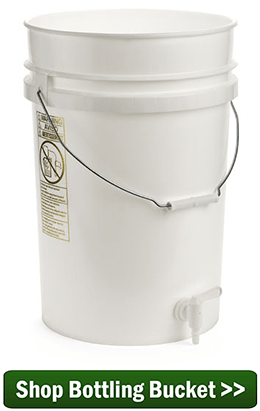
- Gelatin – Similar to Isinglass, gelatin is a beer fining derived from animal collagen. It works by attaching to negatively charged yeast and protein, thereby increasing the size of the particle and helping it to settle out.
Since Irish moss is negatively charged and the collagen finings are positively charged, you may find that using them both produces good results. When using finings in beer, be sure to follow the instructions on the package and mix the fining agent appropriately. There’s no need to use more than is recommended by the manufacturer.
Other Tools for Clarification
If using finings in beer is something you are hesitant to do, you can still clear your beer with other methods:
- Time – Given enough time, any particulate that’s more dense than beer will settle out eventually. Consider lengthening your secondary fermentation period to improve clarity. Time can often clear a beer just a well as any beer fining.
- Temperature – Cold temperature helps protein and tannin particulate settle out. As little as a day of refrigeration can make a big difference in clarity.
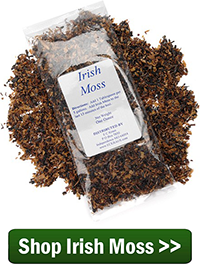
- Filtration – If you’re in a rush, you can certainly save time by filtering your homebrew beer. These systems are not inexpensive, and you may need a draft system to push the beer through the filter.
Remember that some beers are supposed to be cloudy, in particular, hefeweizens and witbiers. You may wish to omit using finings in such beers. But for your pale ales, porters, and lagers, a bit of home brew beer finings may be just what you need for a crystal clear brew!
—–
David Ackley is a beer writer, brewer, and self-described “craft beer crusader.” He holds a General Certificate in Brewing from the Institute of Brewing and Distilling and is founder and editor of the Local Beer Blog.
Meet the Microbes Who Cause Homebrew Contamination
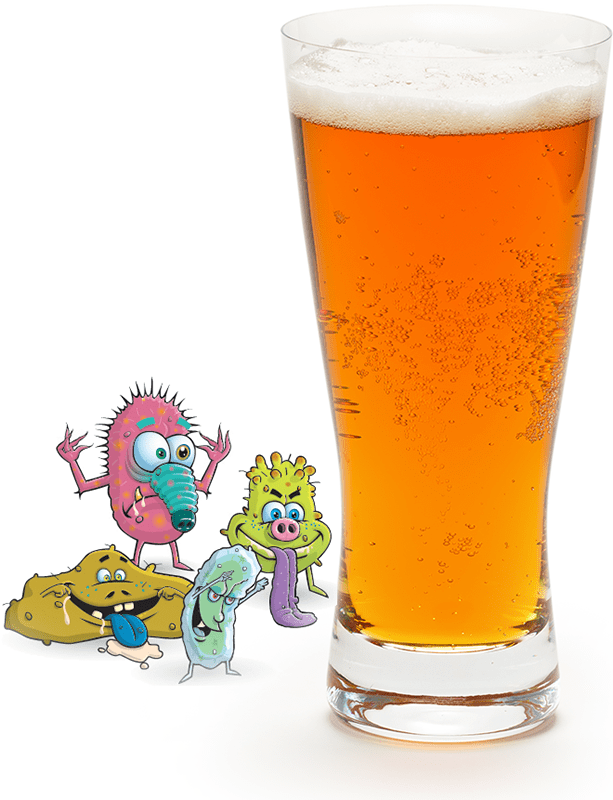 Blogger Bill Downs introduces us to the opponents in the opposite corner of the homebrewing ring: the microbes that can spoil you beer!
Blogger Bill Downs introduces us to the opponents in the opposite corner of the homebrewing ring: the microbes that can spoil you beer!
—–
I remember my first beer very well. It was an extract kit with a pound of grain, sometimes called a partial mash. It was a stout and a good one.
What did I do right? In spite of being under-equipped and inexperienced, I did some things right. I followed the directions in the kit to the letter, and the most important thing I did was to make sure everything was sanitized! Why?
There are two natural spoilers that are guilty of causing homebrew contamination:
- Wild Yeast
- Bacteria
Wild Yeast Contamination:
Let’s examine this with a little more detail starting with wild yeast. When it comes to homebrew contamination, there are two broad types of wild yeast:
- Saccharomyces, which can cause flavor defects and also cause over performance of the fermentation process.
- Non-Saccharomyces: They produce acid and cause strong mousey flavors, films and unusual esters (fruit or bubble gum flavors).
There are some types of non-saccharomyces yeasts, such as Brettanomyces bruxellensis (Brett for short), that are intentionally allowed in some types of beers. An example of this particular yeast is what you find in Lambic style beers. The smell of “sweaty horse blankets” is a common smell that comes from Brett.
As a rule however, you never want this type of yeast in beer. Not only does non-saccharomyces strains cause off-flavors, some brewers will tell you they are almost impossible to clean off of equipment (especially plastic) and it will continue to taint all your beers with off-flavors. That depends on whom you ask, but some breweries take it seriously enough to use separate equipment for their Brett beers.
Bacterial Contamination:
Here are some details about homebrew contamination through bacterial infection. There are six basic types of bacteria brewers need to watch for. These are:
- Lactic acid bacteria: Probably the most problematic bacterial contamination because it can survive in a low oxygen environment and is tolerant to low pH, high alcohol, and hops.
- Common brewer’s bacteria: These are less troublesome because they don’t do well in a pH of higher than 4.2, but should not be discounted – they will still cause off-flavors.
- Acetic acid bacteria: These are particularly bad since they metabolize ethanol into vinegar.
- Pectinatus: This type of homebrew bacterial contamination produces fatty acids and acetic acids.
- Megashaera: These poisonous bacteria produce hydrogen sulfide, which causes a rotten egg smell.
- Zymomonas: These are very potent. They survive well in high alcohol and a low pH environment. Fortunately, zymomonas is not very often found and seems to confine itself to ale breweries.

All these bacteria can be found in raw homebrewing materials such as grain, hops, additives, vessels, tubes and other brewing equipment. This is why cleanliness and sanitation are next to beer Godliness!
But, don’t let this scare you! Here is all you have to know to completely avoid any type of homebrew contamination:
- Clean all around you.
- Clean all equipment and sanitize.
- Clean and sanitize anything that will come in contact with the beer.
If you do these things, there is no reason to worry about wild yeast or homebrew bacterial contamination. Or as Charles Papazian would say, “Relax, don’t worry, have a homebrew!”
—–
In 2000, after a lot of reading and research, Bill Downs started homebrewing. He founded, and then became the president of his local homebrew club, the Mesa Verde Mashers. Bill is a contributing reporter for the Rocky Mountain Brewing News, a BJCP Beer Judge, and owner and webmaster of www.homebrewingnews.com.
The Difference Between Malt Extract vs All Grain Brewing
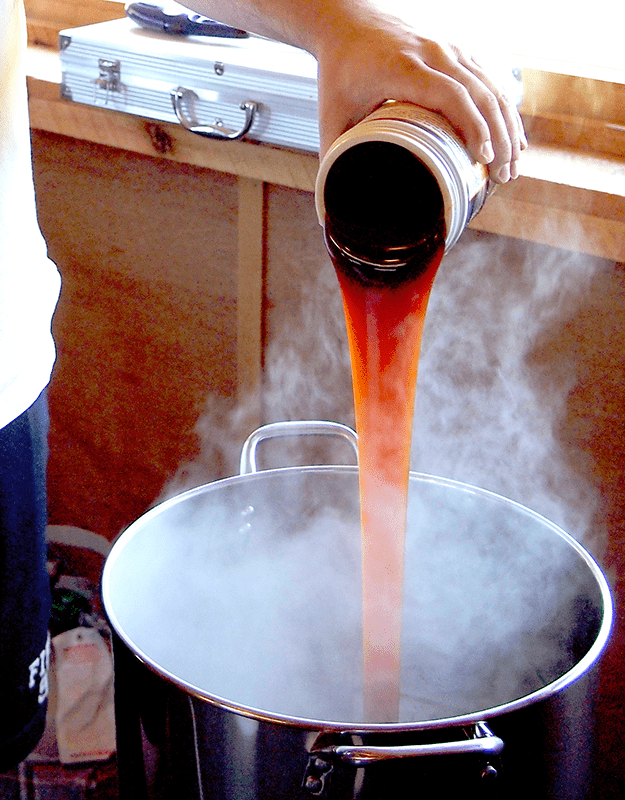 One of the eternal debates in the world of homebrewing is around the merits of malt extract vs all grain brewing. There’s no one-size-fits-all answer to the questions. Homebrewers who love to make beer the way the professionals do it prefer all grain brewing. Homebrewers with limited time, space, and equipment may find it easier to brew with malt extract. Though you will hear some people say that all grain brewing makes better beer, it is certainly possible to make great beer with malt extract, and conversely bad beer with all grain. Taste is not a concern here.
One of the eternal debates in the world of homebrewing is around the merits of malt extract vs all grain brewing. There’s no one-size-fits-all answer to the questions. Homebrewers who love to make beer the way the professionals do it prefer all grain brewing. Homebrewers with limited time, space, and equipment may find it easier to brew with malt extract. Though you will hear some people say that all grain brewing makes better beer, it is certainly possible to make great beer with malt extract, and conversely bad beer with all grain. Taste is not a concern here.
Whether you brew using extract or grain, it will ultimately be a decision based on your needs and constraints. Here are some of the primary differences between malt extract vs all grain brewing to consider when deciding which method to use in your home brewery:
Malt Extract Benefits
- Faster: With extract brewing, there’s no need to wait 60 minutes for the mash. Just mix the extract with water and you’re ready to start the boil. If you play your cards right, you can be done with a brew in as little as two hours, including cleanup.
- Easier: Again, with extract brewing, we skip the mash. That means no measuring pH and no measuring temperature.
- Less equipment required: When brewing with malt extract, there’s no need for a separate mash tun. This can easily save the homebrewer a hundred dollars or more.
- Less kettle capacity required: When brewing malt extract vs all grain, it’s typical to brew with a smaller kettle. Again, the smaller kettle makes extract brewing more economical for the budget brewer.
Malt Extract Drawbacks
- Higher ingredient cost: You will likely pay more for the malt and hops when brewing with extract. Malt extract tends to cost more than the amount of grain needed to achieve the same gravity. Additionally, extract brewers often use a higher gravity boil. Due to the higher gravity of the boil, hop utilization decreases and it takes more hops to extract an equal amount of bitterness.
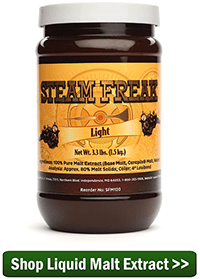
- More difficult to brew lightly colored beers: Between two beers brewed to the same original gravity, one extract, one all-grain: the extract brew will most likely be darker. This can make it tricky to get beers like wits, Kölsches, and hefeweizens to come out on the lighter end of the color spectrum.
All Grain Brewing Benefits
- Ingredients cost less: As previously mentioned, you will probably spend less money brewing all grain vs malt extract when brewing the same beer.
- It’s how the pros do it: If you have aspirations to be a professional brewer, you should learn how to brew all-grain. The mechanics of mashing is very important component of brewing great beer.
All Grain Brewing Drawbacks
- Takes longer: A mash of 60 minutes or longer – plus the sparge – adds a significant amount of time to the brew day. If you’re tight on time, you may want to stick with malt extract.
- More mess: The mash leaves behind a significant amount of wet grain. You have to account for the extra time required to dispose of the grains and clean the mash tun.

- Requires more equipment: As mentioned earlier, all-grain brewing requires some additional equipment. The most economical way to get into all-grain brewing is Brew in a Bag.
There you have it: the pros and cons of malt extract vs all grain brewing. Whether you choose extract or all grain will depend on your cash flow, level of experience, and time availability. Regardless of the method you choose, be confident that you can brew great beers with great taste either way!
—–
David Ackley is a beer writer, brewer, and self-described “craft beer crusader.” He holds a General Certificate in Brewing from the Institute of Brewing and Distilling and is founder and editor of the Local Beer Blog.
